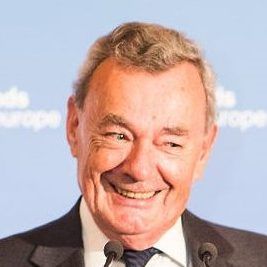Is it still crazy to talk of a 'European army'?
Frankly Speaking
Founder of Friends of Europe
Giles Merritt asks whether EU countries’ panicky and uneven responses to Putin’s war against Ukraine may yet revive support for a ‘European army’.
The notion of a ‘European army’ has been around for years, although widely rejected as crazy and impractical. Defence experts have long explained that merging national forces is impossible because they each have their own proud military history and traditions, not to say that they embody national independence and sovereignty.
Yet the idea refuses to go away, and is edging back onto the EU agenda. Sooner or later, some form of ‘euroforce’ is likely to be formally discussed now that Russia’s invasion of Ukraine is widening into a protracted cold war, with hardened European frontier defences instead of the Iron Curtain.
Concentrating Europeans’ underfunded and neglected armed services into a single striking force has much to recommend it, and four Scandinavian countries are taking a significant first step towards that. Norway, Denmark, Sweden and Finland are to combine their airforces so that their 250-plus military aircraft become a unified command.
The promised closer cooperation between Europe’s national defence industries soon fell victim to cut-throat competition
Bringing together aircraft is obviously easier than creating a new army, but it may be a pointer to the future. With the threat from Putin’s Russia and the costs of rebuilding their national armies staring Europeans in the face, the unthinkable is at least worth considering.
We Europeans have been here before, of course. Twenty-five years ago, UK premier Tony Blair and France’s president Jacques Chirac stepped aboard the visiting British destroyer HMS Birmingham in the Breton port of St Malo to sign an Anglo-French defence pact that would be open to all EU countries. Their St Malo Declaration emphasised the creation of a “European military force capable of autonomous action.”
Needless to say, it all came to nought, or at any rate to very little. The promised closer cooperation between Europe’s national defence industries soon fell victim to cut-throat competition, notably between the UK’s giant BAE Systems, with its strong US connections, and EADS, the military side of Airbus.
Europe’s bid to match the American defence industry’s dominance was stillborn, and its attempts to create a separate ‘defence identity’ fared little better. The European Defence Agency set up in 2004 to coordinate procurement has failed to break down longstanding protectionist walls within the EU. Costly and unnecessary duplication of weapons systems mean US equipment is still generally cheaper and more advanced.
Another failed plan has been the European system of rotating ‘Battlegroups’ to field 5,000 combat-ready troops at short notice. This never really got off the ground, thanks to governments’ complacent belief that the US commitment to NATO meant they could save money by sheltering forever beneath the American nuclear and conventional forces’ umbrella.
Putin’s war caught Europe flat-footed
EU member states’ military top brass in any case share a common prejudice against ‘mixed forces’ that would place personnel from a number of nations under ‘foreign’ commanders. They argue that national ‘esprits de corps’, language difficulties and strongly-rooted military cultures make the concept of a pan-European force so difficult as to be unthinkable.
These remain important factors, but they are looking less insuperable now the true scale of Europe’s defence weakness is laid bare. Europe’s armed forces may be collectively the world’s largest at two million people, but wearing a uniform isn’t the same as being combat-ready. Estimates of deployable personnel vary between two and five per cent.
Putin’s war caught Europe flat-footed, and also confirmed the US ‘pivot to Asia’ means the Pentagon’s focus has moved away from Europe. NATO’s mid-2022 summit in Madrid indicated that it will therefore be mainly Europeans that make up the alliance’s new rapid response force of 300,000 troops deployable at a month’s notice, and half a million in six months.
Called the ‘New Force Model’, this NATO catch-up effort is still only a plan. On both sides of the Atlantic, the alliance’s members have been scrambling to meet Ukraine’s equipment needs, and the strain is beginning to tell. “Increasingly, it’s more about banks than tanks,” says one expert of financing difficulties that are compounded by the economic aftermath of the covid pandemic and promised boosts to EU members’ defence budgets.
Whether under the auspices of NATO or the EU, the nub of the problem is that European governments have made promises they can’t deliver on. Advocates of a collective defence architecture – whether called a European army, or not – can expect a more sympathetic hearing. It’s a message that would certainly command respect in the Kremlin, where Europe’s fragmented defences are widely believed to have fuelled Vladimir Putin’s aggression.
The views expressed in this Frankly Speaking op-ed reflect those of the author and not of Friends of Europe.
You may also like…
- Friends of Europe: Peace, Security and Defence Summit – beyond the aftermath: envisioning the new security normal
- #CriticalThinking: Digging in for the long haul in Ukraine: the Army of the East and the Army of the West, by Jamie Shea
- Debating Europe: Securing Our Future: 100 African & European Voices on Climate Change, Conflict and Security
Stay informed
